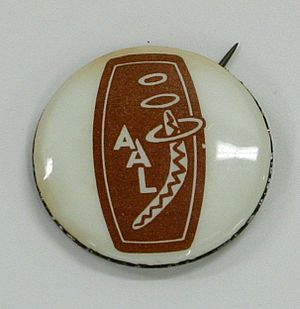Aboriginal Advancement League facts for kids
| Nickname | AAL |
|---|---|
| Predecessor | Australian Aborigines' League & Save the Aborigines Committee |
| Formation | 1957 |
| Founded at | Melbourne |
| Purpose | Indigenous rights campaigning |
| Location |
|
|
Region
|
Victoria, Australia |
|
Formerly called
|
Victorian Aborigines Advancement League |
The Aboriginal Advancement League (AAL) is an important group in Australia that helps and supports Aboriginal people. It started in 1957, making it the oldest organization of its kind that is still active today. At first, it was called the Victorian Aborigines Advancement League (VAAL).
The League is based in Melbourne and works to protect the rights and culture of Aboriginal Australians. It also publishes a journal called Smoke Signals.
Contents
How the League Started
The League was created in March 1957 to help Aboriginal people in the state of Victoria. At the time, a government report suggested that some Aboriginal people should have to leave their homes on special lands called reserves at Lake Tyers and Framlingham.
The people living there objected to this, and their campaign to stay led to the creation of the League. The group was formed by joining two other organizations: the Australian Aborigines League and the Save the Aborigines Committee.
Some of the founding leaders were Gordon Bryant, Doris Blackburn, Stan Davey, and Sir Douglas Nicholls.
Fighting for Rights
In its early years, the League worked on important issues. It pushed for a special vote, called a referendum, to change the Australian Constitution. This change would allow the main Australian government to make laws for Aboriginal people, which was seen as a step toward equality.
The League also helped famous artist Albert Namatjira when he got into trouble for breaking rules that many people felt were unfair.
By 1967, the League was fully run by Aboriginal people. Its first Aboriginal president was Bill Onus.
The Influence of Black Power
In 1968, the League invited an activist from the Caribbean named Roosevelt Brown to speak in Melbourne. He talked about "Black Power," an idea from America that encouraged Black people to be proud of their culture and to lead their own communities.
This idea was already growing in Australia, especially after the famous "Freedom Ride" in 1965, led by Charles Perkins. The visit from Roosevelt Brown helped spread these ideas of pride and empowerment even further.
The League's Home in Melbourne
In 1999, the government of Victoria helped renovate the League's main building in the suburb of Thornbury.
Today, this building is more than just an office. It is a community center and also has a museum. This museum is a "keeping place" for objects that are important to the history, culture, and spirit of Aboriginal people.
What the League Does Today
The Aboriginal Advancement League continues to help Koorie (Aboriginal people from southeastern Australia) communities. It offers many services, including:
- Support for families
- Help with getting food
- Advocacy, which means speaking up for people's rights
- Counselling and educational programs
- Funeral services for community members
The League also has a Cultural Unit. This team provides speakers and information to schools to teach others about Aboriginal culture and history.


